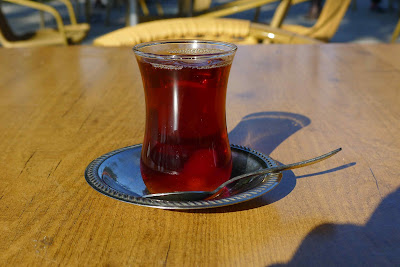 |
| Ada cafe cat - a rascally thing that loves cuddles |
During my last trip to Turkey back one freezing week in November 2008, I discovered two things of note: 1) this fabulous neighborhood of Cihangir in a corner of Beyoglu perched above the Bosphorus and 2) the myriad cats that lounge, decorate, entertain and pervade this corner of the magic ancient city. The chic low-key but super hip neighborhood coupled with the cats and the piles of cat biscuits that cat-loving istanbullus serve up in doorways, street corners and convenient nooks for their feline friends made a huge impression on me then. Now I am back enjoying it in the glory of late summer breezes, amazing food, the civilized blend of a east-west amenities and general yummy exoticness.
{Some may know that the past 6 months has seen me riding out the interminable, unbearable noise, heat, smells and chaos of Delhi - so Cihangir and its cats provide healing balm to my battered senses.}
If you are a cat hater then read no further.
 |
| Greeter of tourists |
 |
| Chora church museum resident will jump on you given half the opportunity - cuddly! |
Not only are there many cats but it turns out that they all want to know me, I am assailed by purred greetings, miaos, raised tails in salute when they see me coming REGARDLESS if I am holding anything edible. This is a source of extreme gratification to a TCOCL*.This especially after months of enduring streets full of battered wild dogs and cats that are unloved, run-over, kicked and generally badly treated in India.
 |
| Cats enhance the tourist experience |
I am daily surprised by seeing the most unlikely men stoop down to pat a cat, invite one onto his lap at a cafe or call out to one in the street. I'm not talking about sensitive intellectual types but all kinds from the crusty old fisherman to the mustachioed tough-guy.
 |
| Cat lodging on Buyuk Ada Island |
 |
| Island cat |
 |
| Island cat |
 |
| Island cat |
 |
| Chora Church resident |
 |
| Young member of the Chora church cat community |
 |
| Metro cat at Aksaray |
Cats are everywhere - except the mosque. Cats in the museums, cafes, shops, restaurants, parks, hanging around the waterfront,
and of course in the bazaar.
 |
| Luxurious lingerie store cat |
Not only are cats everywhere but also the cat theme is prevalent in shops and art around the city.
 |
| Cat art |
 |
| The Red Cat bookstore |
While I am not quite sure that the cat theme is exactly top-of-mind in the Istanbullus psyche, it nevertheless warms my heart to experience a city and its people so obviously loving towards these animals.
* TCOCL: That Crazy Old Cat Lady
yes.. I know... why fight it?
























































